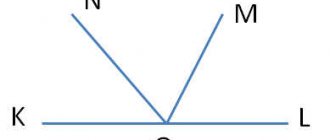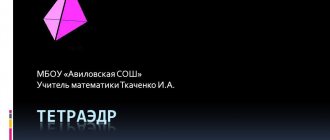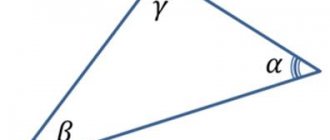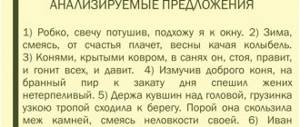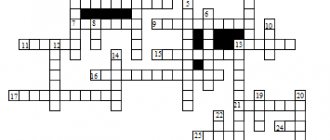TESTS ON GEOMETRY IN 11TH GRADE FROM THE TEXTBOOK ATANASYAN L.S.
Test No. 1 The simplest problems in coordinates
Option 1
1. Find the coordinates of the vector if A (5; –1; 3), B (2; –2; 4).
2. Given vectors (3; 1; –2) and (1; 4; –3). Find .
3. Draw the Oxyz coordinate system and construct point A (1; –2; –4). Find the distances from this point to the coordinate planes.
Option 2
1. Find the coordinates of the vector if C (6; 3; – 2), D (2; 4; – 5).
2. Given vectors (5; – 1; 2) and (3; 2; – 4). Find .
3. Draw the Oxyz coordinate system and construct point B (– 2; – 3; 4). Find the distance from this point to the coordinate planes.
Test No. 2 Angle between vectors. Dot product of vectors
Option 1
1. Calculate the scalar product of the vectors and , if , , = 2, = 3, = 60°, , .
2. Given a cube ABCDA1B1C1D1. Find the angle between lines AD1 and BM, where M is the midpoint of edge DD1.
3. . When moving, straight line a is mapped onto straight line a1, plane α - onto plane α1, and . Prove that .
Option 2
1. Calculate the scalar product of the vectors and , if , , = 3, = 2, = 60°, , .
2. Given a cube ABCDA1B1C1D1. Find the angle between lines AC and DC1.
3. When moving, the straight line is mapped onto the straight line b1, and the plane β is mapped onto the plane β1 and b || β1
Test No. 3 Cylinder. Cone. Ball
Option 1
1. The axial cross-section of the cylinder is square, the area of the base of the cylinder is 16π cm2. Find the surface area of the cylinder.
2. The height of the cone is 6 cm, the angle at the apex of the axial section is 120°. Find:
a) the cross-sectional area of a cone by a plane passing through two generatrices, the angle between which is 30°;
b) the area of the lateral surface of the cone.
3. The diameter of the ball is 2m. A plane is drawn through the end of the diameter at an angle of 45° to it. Find the length of the line of intersection of the sphere with this plane.
Option 2
1. The axial section of the cylinder is a square, the diagonal of which is 4 cm. Find the surface area of the cylinder.
2. The radius of the base of the cone is 6 cm, and the generatrix is inclined to the plane of the base at an angle of 30°. Find:
a) the cross-sectional area of a cone by a plane passing through two generatrices, the angle between which is 60°;
b) the area of the lateral surface of the cone.
3. The diameter of the ball is 4m. A plane is drawn through the end of the diameter at an angle of 30° to it. Find the cross-sectional area of the sphere by this plane.
Test No. 4 Volumes of bodies
Option 1
1. The apothem of a regular triangular pyramid is 4 cm, and the dihedral angle at the base is 60°. Find the volume of the pyramid.
2. A prism is inscribed in the cylinder. The base of the prism is a right triangle, the leg of which is 2a and the adjacent angle is 30°. The diagonal of the larger side face of the prism makes an angle of 45° with the plane of its base. Find the volume of the cylinder.
Option 2
1. The lateral edge of a regular triangular pyramid is 6 cm and makes an angle of 60° with the plane of the base. Find the volume of the pyramid.
2. A pyramid is inscribed in a cone. The base of the pyramid is a right triangle, the side of which is 2a, and the adjacent angle is 30°. The side face of the pyramid passing through this leg makes an angle of 45° with the plane of the base. Find the volume of the cone.
Test No. 5 Volume of the ball and its parts
Option 1
1. The diameter of the ball is equal to the height of the cone, the generatrix of which makes an angle of 60° with the plane of the base. Find the ratio of the volumes of the cone and the sphere.
2. The volume of the cylinder is 96π cm3, its axial cross-sectional area is 48 cm2. Find the area of the sphere circumscribed around the cylinder.
Option 2
1. A sphere is inscribed in a cone whose axial section is a regular triangle. Find the ratio of the area of the sphere to the area of the lateral surface of the cone.
2. The diameter of the ball is equal to the height of the cylinder, the axial section of which is a square.
Find the ratio of the volumes of the cylinder and the sphere. Author: Vorontsova Elena Nikolaevna
Test on the topic "Cylinder"
Test: “Test on the topic “CYLINDER””.
Test taker: _______________________________ Date: _____________________
Instructions:
All necessary instructions are formulated in the task itself. Good luck!
Test evaluation criteria:
Possible maximum points: 15.
“5” no less than 13 points (85% max.);
“4” no less than 10 points (70% max.);
“3” no less than 8 points (50% max.);
Only 100% correct answers are counted.
| Task No. 1 | ||||||
| Choose the correct definitions of cylinder | ||||||
| Select several of 5 answer options: | ||||||
| 1) | is a geometric body bounded by a cylindrical surface and two parallel planes intersecting it | |||||
| 2) | this is a body that consists of two circles that are combined during parallel transfer | |||||
| 3) | this is a body obtained by rotating a rectangle around one of its sides as an axis | |||||
| 4) | this is a multifaceted body | |||||
| 5) | is a body bounded by a surface and circles | |||||
| Task No. 2 | ||||||
| Name the type of cylinder shown in the figure | ||||||
| Choose one of 5 answer options: | ||||||
| 1) | simple | |||||
| 2) | straight | |||||
| 3) | rectangular | |||||
| 4) | ordinary | |||||
| 5) | arbitrary | |||||
| Task No. 3 | ||||||
| Match the names of the main elements of the cylinder with the symbols in the figure: | ||||||
| Please select a match for all 5 answer options: | ||||||
| 1) | A.K. | 1) | cylinder height | |||
| 2) | D.B. | 2) | top base diameter | |||
| 3) | KJ | 3) | cylinder radius | |||
| 4) | E.G. | 4) | generatrix | |||
| 5) | D.H. | 5) | bottom base diameter | |||
| Task No. 4 | ||||||
| Name the type of cylinder | ||||||
| Choose one of 5 answer options: | ||||||
| 1) | crooked | |||||
| 2) | straight | |||||
| 3) | inclined | |||||
| 4) | oblique | |||||
| 5) | rectangular | |||||
| Task No. 5 | ||||||
| By rotating what geometric figure can a cylinder be obtained? | ||||||
| Choose one of 4 answer options: | ||||||
| 1) | parallelogram | |||||
| 2) | triangle | |||||
| 3) | circle | |||||
| 4) | square | |||||
| Task No. 6 | ||||||
| What geometric figure is the section of a straight cylinder by a plane parallel to its axis? | ||||||
| Choose one of 5 answer options: | ||||||
| 1) | arbitrary figure | |||||
| 2) | rectangle | |||||
| 3) | circle | |||||
| 4) | square | |||||
| 5) | oval | |||||
| Task No. 7 | ||||||
| How many generatrices can be drawn in a cylinder? | ||||||
| Choose one of 4 answer options: | ||||||
| 1) | one | |||||
| 2) | two | |||||
| 3) | three | |||||
| 4) | a lot of | |||||
| Task No. 8 | ||||||
| What geometric figure is the axial section of a straight cylinder? | ||||||
| Choose one of 5 answer options: | ||||||
| 1) | circle | |||||
| 2) | rectangle | |||||
| 3) | square | |||||
| 4) | arbitrary figure | |||||
| 5) | oval | |||||
| Task No. 9 | ||||||
| the distance between the planes in which the bases of the cylinder lie | ||||||
| Choose one of 4 answer options: | ||||||
| 1) | cylinder measurement | |||||
| 2) | cylinder radius | |||||
| 3) | cylinder height | |||||
| 4) | cylinder generatrix | |||||
| Task No. 10 | ||||||
| What is the lateral surface of the cylinder? | ||||||
| Choose one of 4 answer options: | ||||||
| 1) | Oval | |||||
| 2) | Circle | |||||
| 3) | Rectangle | |||||
| 4) | Triangle | |||||
| Task No. 11 | ||||||
| What is the section of a cylinder drawn by a plane perpendicular to the axis? | ||||||
| Choose one of 4 answer options: | ||||||
| 1) | Oval | |||||
| 2) | Circle | |||||
| 3) | Rectangle | |||||
| 4) | Triangle | |||||
| Task No. 12 | ||||||
| The area of the base of the cylinder is calculated by the formula | ||||||
| Choose one of 4 answer options: | ||||||
| 1) | S=2πr2 | |||||
| 2) | S=2πr | |||||
| 3) | S=πr2 | |||||
| 4) | S=2πrh | |||||
| Task No. 13 | ||||||
| The lateral surface area of the cylinder is calculated by the formula | ||||||
| Choose one of 4 answer options: | ||||||
| 1) | S=2πr2 | |||||
| 2) | S=2πr | |||||
| 3) | S=πr2 | |||||
| 4) | S=2πrh | |||||
| Task No. 14 | ||||||
| The total surface area of the cylinder is calculated by the formula | ||||||
| Choose one of 4 answer options: | ||||||
| 1) | S=2πr(r+h) | |||||
| 2) | S=2π(r+h) | |||||
| 3) | S=2r(r+h) | |||||
| 4) | S=πr(r+h) | |||||
| Task No. 15 | ||||||
| Calculate for cylinder and match | ||||||
| Please select a match for all 4 answer options: | ||||||
| 1) | cylinder base area | 1) | 960π | |||
| 2) | cylinder lateral surface area | 2) | 240π | |||
| 3) | total surface area of the cylinder | 3) | 64π | |||
| 4) | cylinder volume | 4) | 304π | |||
Answers:
| 1)1,2,3 | 2)2 | 3)1-3,2-2,3-1,4-5,5-4 | 4)3 | 5)4 |
| 6)2 | 7)4 | 8)2 | 9)3 | 10)3 |
| 11)2 | 12)3 | 13)4 | 14)1 | 15)1-3,2-2, 3-4,4-1 |
The test was created in the MyTestXPro program and subsequently translated into Microsoft Word.
Collection of independent works on geometry on the topic “Bodies of Rotation”
GBPOU of the city of Moscow "Sports and Pedagogical College" of the Department of Sports and Tourism of the city of Moscow; teacher of mathematics, computer science and ICT: Makeeva Elena Sergeevna
Independent work No. 1 “Cylinder”
Option 1
A rectangle with sides equal to 3*a and 2*a rotates first around one side, then around the other. Calculate the ratio of the areas of the complete surfaces and the areas of the lateral surfaces of the resulting bodies of rotation.
Two mutually perpendicular planes are drawn through the generatrix of the cylinder. Areas of the resulting sections S1 and S2. Find the axial cross-sectional area of the cylinder.
Plane α intersects the bases of the cylinder along chords whose lengths are 16 cm and 12 cm. Calculate the tangent of the angle of inclination of plane α to the planes of the bases of the cylinder if the radius of the bases of the cylinder is 10 and the height is 30 cm.
Option 2
A rectangle with sides equal to 4*a and 3*a rotates first around one side, then around the other. Calculate the ratio of the areas of the complete surfaces and the areas of the lateral surfaces of the resulting bodies of rotation.
Two mutually perpendicular planes are drawn through the generatrix of the cylinder. The area of one of the resulting sections is So, the area of the axial section of the cylinder is S. Find the area of the other resulting section.
Plane α intersects the bases of the cylinder along chords whose lengths are 24 cm and 32 cm. Calculate the tangent of the angle of inclination of plane α to the planes of the bases of the cylinder if the radius of the bases of the cylinder is 20 and the height is 50 cm.
Independent work No. 2 “Cone”
Option 1
The angle at the apex of the axial section of the cone is equal to 2α, the radius of the base of the cone is equal to R.b Find the total surface area of the cone.
The height of the cone is h, the radius of the base is R. A plane is drawn through the top of the cone, cutting off an arc of 60o from the circle of the base. Calculate the cross-sectional area.
Find the axial cross-sectional area of a truncated cone if its height is h, forming L and the lateral surface area S.
Option 2
The angle between the generatrix of the cone and its base is equal to α, the radius of the base of the cone is R. Find the total surface area of the cone.
The height of the cone is h, the radius of the base is R. A plane is drawn through the top of the cone, cutting off an arc of 90o from the circle of the base. Calculate the cross-sectional area.
Find the lateral surface area of a truncated cone if its height is h, forming L and the axial sectional area S.
Independent work No. 3 “Sphere”
Option 1
A sphere of radius 6 cm touches the plane of triangle ABC at the center of its circumscribed circle. Find the distance from the center of the sphere to the vertices of the triangle if AB=3 cm, AC=4 cm, BC=5 cm.
Determine the distance between the centers of the spheres, which are given by the equations x2 + y2 + z2 -2x+6y-4z=5 and x2 +y2+z2+4x+2y+6z=7
A sphere passes through the three vertices of a rhombus with a side equal to 6 cm and an angle of 60o. Find the distance from the center of the sphere to the fourth vertex of the rhombus if the radius of the sphere is 10 cm.
Option 2
A sphere of radius 1.5 cm touches the plane of triangle ABC at the center of the inscribed circle. Find the distance from the center of the sphere to the sides of the triangle if AB=6 cm, AC=8 cm, BC=10 cm.
Determine the distance between the centers of the spheres, which are given by the equations x2 + y2 + z2 +6x-2y-4z=5 and x2 +y2+z2-2x-6y+4z=11
A sphere passes through the three vertices of a rhombus with a side of 8 cm and an angle of 60o. Find the distance from the center of the sphere to the fourth vertex of the rhombus if the radius of the sphere is 10 cm.
Independent work No. 4 “Volumes of a rectangular parallelepiped, a straight prism and a cylinder”
Option 1
Find the volume of a rectangular parallelepiped if the areas of its three faces are 6 cm2, 18 cm2 and 12 cm2.
At the base of a straight prism lies a rhombus with an acute angle α. The smaller diagonal of the prism is equal to d and makes an angle with the plane of the base. Calculate the volume of the prism.
The centers O1 and O2 of the cylinder bases have coordinates (0;1;1) and (4;1;1). One of the points of the base circle with center O2 has coordinates (4;3;-2). Find the volume of the cylinder.
Option 2
Find the volume of a rectangular parallelepiped if the areas of its three faces are 15 cm2, 45 cm2 and 75 cm2.
At the base of a straight prism lies a rhombus with an acute angle α. The major diagonal of the prism is equal to d and makes an angle with the plane of the base. Calculate the volume of the prism.
The centers O1 and O2 of the cylinder bases have coordinates (2;3;3) and (-2;3;3). One of the points of the base circle with center O1 has coordinates (2;5;-1). Find the volume of the cylinder.
Independent work No. 5 “Volumes of an inclined prism, pyramid and cone”
Option 1
In an inclined prism, the side edge is equal to L, the area of the base is S. The angle between the planes of the base and the section perpendicular to the side edge is equal to . Find the volume of the prism.
The sides of the bases of a regular truncated triangular pyramid are equal to a and b (b>a). The side rib is inclined to the base plane at an angle α. Calculate the volume of the pyramid.
Find the volume and surface area of the body obtained by rotating a triangle with sides 6 cm, 25 cm and 29 cm around a straight line passing through the vertex of the smaller angle of the triangle parallel to its smaller side.
Option 2
In an inclined prism, the side edge is equal to L. The angle between the planes of the base and the section perpendicular to the side edge is equal to . The volume of the prism is V. Find the area of the base.
The sides of the bases of a regular truncated triangular pyramid are equal to a and b (b>a). The side face is inclined to the base plane at an angle α. Calculate the volume of the pyramid.
Find the volume and surface area of the body obtained by rotating a triangle with sides 13 cm, 14 cm and 15 cm around a straight line passing through the vertex of the average angle of the triangle parallel to its middle side.
Independent work No. 6 “Volume of a sphere and area of a sphere”
Option 1
The sphere and its two mutually perpendicular sections have a single common point. The cross-sectional areas are 11 π cm2 and 14 π cm2. Find the volume of the sphere and the area of the sphere.
A plane perpendicular to the radius of the ball divides it into parts in a ratio of 2:1, counting from the center of the ball. The cross-sectional area of the ball by this plane is 20π cm2. Calculate the volume of the smaller spherical segment.
A circular sector with an angle of inclination α and a chord a rotates around one of the radii that bounds it. Find the volume of the resulting spherical sector.
Option 2
The sphere and its two mutually perpendicular sections have a single common point. The cross-sectional areas are 13 π cm2 and 23 π cm2. Find the volume of the sphere and the area of the sphere.
A plane perpendicular to the radius of the ball divides it into parts in a ratio of 3:1, counting from the center of the ball. The cross-sectional area of the ball by this plane is 63 π cm2. Calculate the volume of the smaller spherical segment.
A circular sector with an angle of inclination α and a radius R rotates around one of the radii that bounds it. Find the volume of the resulting spherical sector.
Independent work No. 7 “Combinations of round bodies”
Option 1
A sphere of radius R is inscribed in a cylinder. Find the volume and total surface area of the cylinder.
A sphere is described around a cone with generatrix L and base radius R. Determine the radius of the sphere.
A cylinder is inscribed in a cone, the diagonals of its axial section are respectively parallel to the two generatrices of the cone. The generatrix of the cone is equal to L and makes an angle α with the plane of the base. Find the volume of the cylinder and its lateral surface area.
Option 2
A ball is inscribed in a cylinder of height h. Find the volume and total surface area of the cylinder.
A sphere is described around a cone with height h and base radius R. Determine the radius of the sphere.
A cylinder is inscribed in a cone, the diagonals of its axial section are respectively parallel to the two generatrices of the cone. The generatrix of the cone makes an angle α with the plane of the base, the radius of the base of the cone is equal to R. Find the volume of the cylinder and the area of its lateral surface.
Independent work No. 8 “Combinations of polyhedra and round bodies”
Option 1
The generatrix of the cone is equal to L and makes an angle α with the plane of the base. A regular triangular pyramid is inscribed in a cone. Find the volume of the pyramid.
The length of the side of the base of a regular quadrangular pyramid is equal to a, the side face makes an angle α with the plane of the base. Determine the radius of the circumscribed sphere.
At the base of a straight prism lies a right triangle with legs 2 cm and 4 cm. The diagonal of the larger side face forms an angle of 30o with the base. A cylinder is inscribed in a prism. Find the volume of the cylinder.
Option 2
The height of the cone is h. The generatrix of the cone makes an angle α with the plane of the base. A regular triangular pyramid is inscribed in a cone. Find the volume of the pyramid.
The lateral edge of a regular quadrangular pyramid is equal to b, the lateral face makes an angle α with the plane of the base. Determine the radius of the circumscribed sphere.
At the base of a straight prism lies a right triangle with legs of 4 cm and 6 cm. The diagonal of the larger side face forms an angle of 60o with the base. A cylinder is inscribed in a prism. Find the volume of the cylinder.
ANSWERS TO INDEPENDENT WORK
| № p/p | Option | Exercise 1 | Task 2 | Task 3 |
| 1 | 1 | 3:2 and 1:1 | 15 or | |
| 2 | 4:3 and 1:1 | 12.5 or | ||
| 2 | 1 | |||
| 2 | ||||
| 3 | 1 | 6.5 cm | 8 cm or 2 cm | |
| 2 | 2.5 cm | 6 | 6 cm or 2 cm | |
| 4 | 1 | 36 cm3 | sin2 | 52π |
| 2 | 225 cm3 | sin2 | 80 | |
| 5 | 1 | SLcos | (b3 – a3)tg | 1600 cm3 and 1320 cm2 |
| 2 | (b3 – a3)tg | 1344 cm3 and 672 cm2 | ||
| 6 | 1 | cm3 and 100 cm2 | cm3 | sin |
| 2 | 288π cm3 and 144π cm2 | 99 cm3 | ||
| 7 | 1 | 2 and 6 | And | |
| 2 | And | And | ||
| 8 | 1 | sin2 | (7 - 15cm3 | |
| 2 | bctg | 4(19-65) cm3 |
